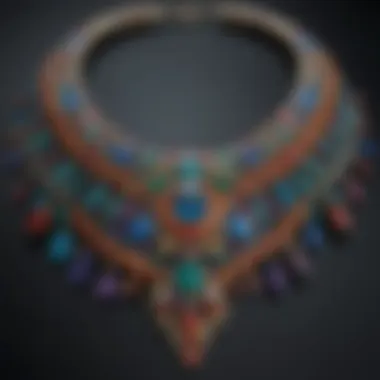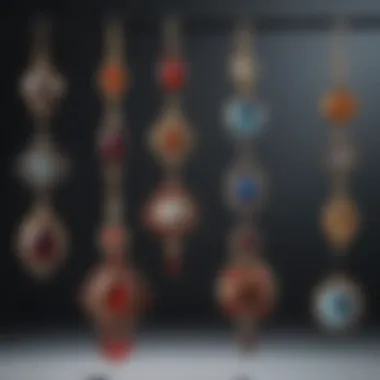Exploring Iconic Costume Jewelry Brands


Intro
Costume jewelry serves as a vibrant segment within the fashion accessories market, allowing individuals to express their personal style without the heavy investment associated with fine jewelry. While often overlooked, the craftsmanship and creativity exhibited in costume jewelry are noteworthy. This article aims to uncover the compelling stories behind some of the most notable brands in this industry. By understanding their histories, design philosophies, and unique offerings, readers can gain insight into the options available to them. This journey through the realm of costume jewelry will enhance informed purchasing choices.
Tips and How-Tos
When navigating the expansive world of costume jewelry, understanding how to select the right pieces can significantly enhance your wardrobe. Below are several practical tips for integrating costume jewelry into your collection.
Know Your Style
Determine your personal aesthetic before making purchases. Do you prefer bold, statement pieces or subtle, delicate designs? Consider the occasions and outfits where you wish to wear these pieces. This reflection will inform your choices and help retain a cohesive style.
Care and Maintenance
Costume jewelry can vary greatly in terms of quality. Proper maintenance ensures longevity. Here are some care tips:
- Keep away from moisture: Humidity can damage metal and materials.
- Store properly: Use a jewelry box with compartments to prevent tangling and scratching.
- Clean regularly: Use a soft cloth to remove dust and oils after each wear.
Layering Techniques
Layering is an effective way to create a personal style statement. Start with a base piece, such as a simple necklace, and add layering elements gradually. Experimenting with various lengths and styles can result in a chic and sophisticated appearance.
“Costume jewelry should not just accompany an outfit; it needs to enhance the overall look.”
Sustainable Practices
Sustainability is becoming increasingly important for consumers across all industries, including fashion. Some costume jewelry brands are implementing eco-friendly practices to reduce their environmental footprint.
Eco-Friendly Brands
Brands like BaubleBar and Stella & Dot are pioneering efforts in sustainable practices. They utilize recycled materials and ethical sourcing to create their unique pieces. By supporting these brands, consumers contribute to a greener environment while enjoying fashionable accessories.
Tips for Sustainable Grooming
- Choose quality over quantity: Investing in fewer, high-quality pieces promotes sustainability.
- Research brands: Understand the company’s practices regarding sustainability before purchasing.
Celebrating Diversity in Beauty
Diversity is essential in every industry, and costume jewelry is no exception. Brands increasingly recognize the importance of inclusivity and cultural influences in their designs.
Inclusive Brands
Brands such as Etnies and Missoma actively celebrate diversity in their collections. Their designs often reflect various cultural influences, showcasing unique patterns and materials.
Cultural Influences on Fashion
The impact of cultural heritage on jewelry design can be profound. By integrating traditional craftsmanship with modern aesthetics, these brands tell stories that resonate with diverse audiences.
Prelims to Costume Jewelry
Costume jewelry occupies a significant space in the accessories market, bridging the gap between affordability and aesthetic appeal. As fashion evolves, the role of costume jewelry becomes increasingly crucial. This section will outline the defining characteristics of costume jewelry and its importance in the fashion landscape.
Defining Costume Jewelry
Costume jewelry can be understood as adornments made from less expensive materials, unlike fine jewelry that uses precious metals and gemstones. Typical materials include glass, plastic, and base metals. The primary goal of costume jewelry is to allow wearers to enjoy the beauty of accessories without the high price tag often associated with fine jewelry.
Costume jewelry serves various functions. Some pieces are designed purely for decorative purposes, while others can signal social status or personal style. Its adaptability makes it a popular choice in modern fashion, catering to diverse tastes and preferences.
The Significance of Costume Jewelry in Fashion


Costume jewelry holds a unique place within the fashion ecosystem. It empowers individuals to express their personal style without breaking the bank. Wearers can curate their looks with different pieces, reflecting creativity and individual flair.
Furthermore, costume jewelry helps to democratize access to fashion. Unlike luxury brands that might restrict their offerings to a select clientele, costume jewelry brands often aim for inclusivity. This creates a dynamic market where varied individuals can engage with fashion on their terms.
Costume jewelry also embraces trends and seasonal styles, allowing consumers to adapt their looks according to shifting fashions. It fosters innovation as brands experiment with bold designs and playful aesthetics, pushing the boundaries of traditional jewelry.
Historical Context of Costume Jewelry
Understanding the historical context of costume jewelry provides essential insights into why these accessories have garnered significant attention and appreciation. Throughout different eras, the purpose and perception of costume jewelry have transformed, reflecting not only fashion trends but also societal values and economic conditions. This context helps to appreciate the evolution of designs and the various influences that shaped well-known brands.
In an era where individuality and self-expression are paramount, costume jewelry serves as an accessible means for people to express their personal style without the staggering financial burden often associated with fine jewelry. Its accessibility allows broader participation in fashion trends.
Origins and Evolution
Costume jewelry originated in France during the 18th century. Initially, these pieces were designed for the upper classes to imitate fine jewelry. They were made from affordable materials such as glass, wood, and base metals. The evolution of costume jewelry accelerated during the 1920s and 1930s when Hollywood spread glamour. Costume jewelry was popularized by iconic figures who adorned themselves with extravagant pieces, making them desirable to the general public.
By the mid-20th century, brands like Trifari, Coro, and Monet emerged, focusing on innovative designs and quality materials. The introduction of mass production revolutionized the industry, making costume jewelry more widely available. Designers began experimenting with bold shapes, bright colors, and intricate detailing, appealing to diverse markets. The ability to adapt to changing trends ensured its enduring relevance.
Key Historical Figures
Several influential figures have played critical roles in the development of costume jewelry. One prominent designer is Coco Chanel, known for integrating costume jewelry into high fashion. She advocated for the idea that women could mix and match pieces, making jewelry an essential element of casual style.
Another significant figure is Kenneth Jay Lane, who crafted whimsical and daring pieces that appealed to both celebrities and the fashion-forward crowd. His work cemented the notion that costume jewelry could be luxurious and unique, challenging traditional norms.
The impact of artists and designers in this field cannot be understated. Their visions helped to shape consumer preferences and remained pivotal in the growth of the costume jewelry movement. By understanding the origins and key contributors to this market, one can truly grasp the importance and appeal of costume jewelry brands today.
Key Attributes of Esteemed Costume Jewelry Brands
To understand what makes a costume jewelry brand stand out, we must look closely at key attributes that are essential for success. These attributes not only define the identity of a brand but also influence consumer perception and choice. Quality of materials and innovative designs are pivotal in determining the value and desirability of costume jewelry. When shoppers seek unique pieces, they often consider these elements to ensure their purchase aligns with both style and expectations.
Quality of Materials
The choice of materials in costume jewelry transcends mere aesthetics; it reflects on the brand's commitment to quality and sustainability. Many esteemed brands prioritize materials that enhance durability while maintaining an elegant appearance. For instance, the use of high-grade metals, like brass or stainless steel, alongside colorful resins or glass, creates pieces that are eye-catching yet robust.
Additionally, brands such as Chanel and Tiffany & Co. utilize exquisite faux pearls and crystals. They are prime examples of how the careful selection of materials can affirm a brand's reputation. Customers frequently prefer these materials not just for their look but also for their weight and feel. Lightweight options are particularly sought after for their comfort during prolonged wear.
Not only does good material elevate the jewelry, but it also signifies a brand's ethical stance. Many modern brands now focus on sustainable sourcing. This means obtaining materials from certified sources that do not exploit workers or damage the environment. By doing this, they attract conscientious consumers who are eager to invest in brands that demonstrate social responsibility.
Innovative Designs
When it comes to costume jewelry, innovative design plays a crucial role in capturing consumer interest and setting a brand apart. This creativity is not confined only to shapes and colors; it extends to how the jewelry is worn and styled. For example, the use of mixed media or incorporating unconventional items into designs demonstrates a refreshing approach.
Brands like Betsey Johnson and Kate Spade excel in this regard. Their use of unexpected color combinations and whimsical motifs can turn a simple piece of jewelry into a statement accessory. As fashion trends evolve, these brands adapt their designs to reflect contemporary styles while still paying homage to classic elements.
Moreover, the influence of technology in jewelry making is significant. Some brands are employing 3D printing techniques to create intricate designs that were once deemed impossible. Each piece becomes not just an accessory but a work of art.
An Overview of Prominent Costume Jewelry Brands
Costume jewelry brands play a pivotal role in shaping the accessories market. They offer a variety of designs that allow individuals to express their style affordably. This section aims to provide a detailed exploration of some of the more notable costume jewelry brands, highlighting their unique contributions to fashion.
Brand A: Overview and Offerings
Brand A has established itself as a key player within the costume jewelry landscape. Known for its bold designs and vibrant colors, the brand captures attention effortlessly. Their offerings include a diverse range of items such as necklaces, earrings, and bracelets, each designed to cater to various tastes. A notable aspect of Brand A is its commitment to keeping up with fashion trends while still maintaining a signature style.
The use of innovative materials, including acrylics and metal alloys, enhances the overall aesthetic, making pieces visually striking yet accessible.
Brand B: Craftsmanship and Design
Brand B emphasizes craftsmanship and design in every piece it creates. The brand's approach involves meticulous attention to detail, ensuring that each item is not only stylish but also made to last. Techniques such as hand-painting and precise metalwork are commonly employed, showcasing the artisans' skills and dedication.
Whether it’s a pair of earrings or a statement necklace, Brand B's pieces often feature intricate patterns or unique color combinations that reflect sophistication. Their designs appeal to individuals who appreciate a fusion of quality and artistry in costume jewelry.


Brand C: Unique Selling Proposition
Brand C distinguishes itself through its unique selling proposition centered around personalized jewelry. This brand has found a niche in offering customizable pieces, allowing customers to engrave initials, dates, or meaningful symbols. This personalization can be seen not only in jewelry but also in packaging and branding, providing an individualized customer experience.
The ability to design a piece specifically for oneself or as a gift adds significant emotional value. This level of customization resonates with many consumers, making Brand C a strong contender in the costume jewelry segment.
Brand D: Target Market and Appeal
Brand D's target market encompasses a broad demographic ranging from young adults to established professionals. This brand characterizes itself as inclusive, focusing on styles that transcend generations. Their collection features trendy pieces that are easily integrated into daily outfits, making them suitable for various occasions, from casual to formal settings.
The marketing strategy is tailored towards social media platforms, where they engage with younger audiences through vibrant visuals and influencer collaborations. This approach increases the brand's visibility and fosters a community around costume jewelry.
Brand E: Sustainability Practices
In recent years, sustainability has become a focal point for many consumers. Brand E addresses this trend by implementing sustainability practices in its production processes. This brand sources ethical materials, ensuring they have a minimal environmental impact. From recycled metals to responsibly sourced gemstones, Brand E’s commitment to sustainability appeals to eco-conscious consumers.
Moreover, their packaging is eco-friendly, further highlighting their dedication to environmental responsibility. Such initiatives not only increase brand loyalty but also contribute positively to their public image.
"Embracing sustainability reflects a commitment not only to consumers but to the planet as well."
Factors Influencing Brand Selection
Selecting the right costume jewelry brand is a pivotal decision for many consumers. It extends well beyond mere aesthetics. Understanding the factors that drive these selections can enhance the purchasing experience and ensure satisfaction. The primary elements influencing brand selection include price point considerations and personal style alignment.
Price Point Considerations
Price is a significant factor when choosing a costume jewelry brand. The market offers a vast range of options, from affordable pieces to high-end selections. Consumers often assess their budget against the perceived value of the jewelry. It is crucial to remember that a higher price does not always equate to better quality. Thus, evaluating the quality of materials used is essential. Brands like Chanel and Van Cleef & Arpels may offer pieces at a premium, but the craftsmanship and materials justify prices.
Considerations include:
- Quality vs. Cost: Does the piece use durable materials? Is it handmade?
- Longevity: Will the jewelry withstand daily wear? High-quality costume jewelry can last years.
- Brand Reputation: Established brands often come with a price tag, but they also ensure quality assurance.
When assessing decor, looking for occasional discounts or second-hand options can reveal valuable finds. Websites, including reddit.com, have communities discussing quality items at better pricing.
Personal Style Alignment
Personal style alignment plays an essential role in brand selection. Each individual has a unique taste that can dramatically influence their shopping behavior. Understanding one's style aids in selecting pieces that enhance wardrobe versatility. Some consumers prefer the minimalist approach of brands like Tiffany & Co., while others may lean towards the bold, vintage-inspired designs from Betsey Johnson.
Key factors include:
- Wardrobe Compatibility: Does the jewelry mesh well with current clothing?
- Occasion: Consider whether the jewelry suits casual, formal, or business settings.
- Trends vs. Timelessness: Are consumers looking for trendy pieces that change with fashion, or classic items that endure?
Investing time to discern personal style before purchasing can lead to more fulfilling and effective choices.
Sustainability in Costume Jewelry
Sustainability in costume jewelry is gaining significant attention. As consumers become more aware of environmental and social responsibilities, the demand for sustainable and ethically produced jewelry has increased. This section underscores the importance of sustainable practices within the costume jewelry industry. It explores how sourcing ethical materials and employing eco-friendly production methods can benefit both the planet and the consumer.
Sourcing Ethical Materials
Ethical sourcing involves acquiring materials that are responsibly and sustainably obtained. For costume jewelry brands, this means using materials that do not contribute to environmental degradation or exploitation of labor. Brands are now opting for recycled metals, conflict-free gemstones, and vegan alternatives to traditional materials.
- Recycled Metals: Many brands are using metals that are sourced from old jewelry or industrial scraps. This reduces the need for new mining and lowers the environmental impact.
- Conflict-free Gems: The significance of extracting gemstones responsibly cannot be overstated. Jewelry brands strive to ensure their stones are conflict-free, meaning they do not finance violence or unethical labor practices.
- Vegan Materials: As awareness of animal rights grows, some brands are turning to vegan materials like synthetic leather or ethically sourced wood, offering stylish options without harming animals.
By choosing ethical materials, brands not only align with consumer values but also create a transparent supply chain that fosters trust and loyalty among customers.
Eco-friendly Production Practices
Eco-friendly production practices are crucial for minimizing the environmental footprint of costume jewelry. Brands adopting these practices focus on reducing waste and energy consumption.


- Waste Reduction: Some companies are implementing techniques to minimize waste during the production process, such as reusing scraps and adopting precision cutting methods that maximize the use of materials.
- Renewable Energy: Using renewable energy sources, like solar or wind power, in manufacturing facilities helps to lessen carbon emissions. Brands committed to sustainability often invest in green technology.
- Sustainable Packaging: The choice of packaging is also important. Brands that opt for biodegradable or recyclable packaging demonstrate a commitment to environmental stewardship, enhancing their brand appeal.
Sustainable practices in production not only benefit the environment but also resonate with a growing consumer base that prioritizes ethical consumption.
The shift towards sustainability in the costume jewelry sector reflects broader societal trends toward responsible consumption. By sourcing ethical materials and adopting eco-friendly production practices, brands can attract a conscientious customer base while contributing positively to the planet.
Navigating the Market: Shopping Tips
Shopping for costume jewelry requires a keen understanding of both the market and the individual capabilities of each brand. It is essential to arm oneself with insight before diving into purchases. This knowledge empowers potential buyers not just to make informed decisions but also to find pieces that truly resonate with their style and values.
Identifying Authentic Brands
In the vast world of costume jewelry, distinguishing authentic brands from counterfeit options can be challenging. Authentic brands often provide transparency about their production processes and design inspirations. They typically have a recognizable logo and distinct packaging that reflects the brand’s identity.
Important Steps to Identify Authentic Brands:
- Research: Look up the brand’s history and its presence in both physical and online retail outlets.
- Read Reviews: Customer reviews and ratings often give insights into the brand’s reliability and the quality of its products.
- Seek Certifications: Some brands may have certifications that attest to the quality and ethical standards of their materials.
Additionally, engaging in online forums, such as those on Reddit, can offer valuable feedback from seasoned buyers. Often, experienced jewelers share their experiences on platforms like Facebook, enabling shoppers to gather perspectives before finalizing their choices.
Comparing Quality and Price
Price does not always equate to quality, particularly in costume jewelry. To compare effectively, consider the materials used, the intricacy of designs, and the durability of the pieces. Costly items do not automatically translate to better craftsmanship. Therefore, evaluating the offer can be complex.
Factors for Quality Comparison:
- Material Analysis: Determine the actual materials in use. Some pieces may look visually impressive but lack durability, leading to fading or breaking over time.
- Craftsmanship Details: Examine the finishing touches. Well-finished items exhibit attention to detail.
- Brand Reputation: A brand with a long-standing reputation often suggests consistency in quality.
"In costume jewelry, a well-selected piece can elevate any outfit, but understanding its intrinsic value is key. High price tags may entice, but true elegance lies in the details."
To find the best balance between quality and price, browse multiple retailers and compare similar items across the spectrum. Understanding your preferences in style and functionality will lead to satisfying purchases that enhance personal expression in fashion.
The Future of Costume Jewelry Brands
The landscape of costume jewelry is constantly evolving. Understanding the future of costume jewelry brands is important for both consumers and creators. Various factors, including cultural shifts and technological advancements, are influencing how these brands will develop in the coming years. By focusing on these trends, consumers can make informed decisions, and brands can adapt effectively to meet market demand. The future seems poised for brands that embrace innovation while staying true to their core design philosophies.
Trends to Watch
Several trends are emerging in the costume jewelry market that deserve attention. These trends not only show what consumers currently value but also hint at the direction brands may take:
- Sustainability: As awareness about environmental issues increases, brands are integrating sustainable practices. This includes using recycled materials and opting for eco-friendly production methods.
- Customization: Consumers increasingly seek jewelry that reflects their individuality. Brands offering personalized options, such as customizable pieces, are likely to gain popularity.
- Tech Integration: The rise of smart technology extends into jewelry. Some brands are experimenting with wearables that combine style with functionality, like smart rings and bracelets.
- Minimalism and Versatility: Designs that are simple yet versatile are becoming preferred. Consumers appreciate pieces that can be worn for various occasions.
These trends highlight a shift towards a more conscious and consumer-driven market where preferences shape the design and marketing of costume jewelry.
Emerging Brands and Innovations
Emerging brands are pushing the boundaries of what costume jewelry can be. They introduce innovative materials and techniques that set them apart:
- New Materials: Brands are exploring alternatives to traditional materials. Innovative designers are using bio-resins, lab-created stones, and even materials derived from plants.
- Artisanal Craftsmanship: There is a noticeable rise in brands valuing craftsmanship. Artisans create unique pieces that tell a story, drawing consumers who appreciate the narrative behind their jewelry.
- Digital Presence: Online platforms allow new brands to reach a wider audience. Social media plays a crucial role in branding, allowing for direct consumer engagement and feedback.
"Emerging brands often reflect the values of the modern consumer, focusing on authenticity, sustainability, and community."
As the market becomes increasingly competitive, these innovations could position emerging brands as key players in the future standard of costume jewelry, appealing to a meticulous audience.
The End
Costume jewelry brands play a pivotal role in the fashion industry. They offer styles that cater to varied tastes and preferences. This article highlights the essential aspects of notable costume jewelry brands. Factors like craftsmanship, innovative designs, and sustainability practices shape their significance.
Final Thoughts on Costume Jewelry Brands
Costume jewelry represents more than just adornments. It embodies creativity and personal expression. Many brands embrace distinct design philosophies, allowing consumers to find pieces that resonate with their identity. Brands such as Chanel and Patricia Locke exemplify this, combining artistic vision with accessibility. This combination ensures their enduring popularity.
Embracing Personal Style through Accessories
Accessories are a powerful tool for self-expression. They enable individuals to communicate their personality without words. Costume jewelry, in particular, provides flexibility. A statement necklace can transform a simple outfit into a striking ensemble. Similarly, a pair of bold earrings can enhance one’s presence. It is important to choose pieces that align with one's personal style. This thoughtful selection cultivates a wardrobe that reflects individuality.
Moreover, understanding the craftsmanship behind these accessories adds value. Knowing about the materials and techniques enriches the buying experience. As consumers become more aware, they can make informed decisions about their purchases.
Thus, embracing personal style through costume jewelry is an empowering journey, encouraging creativity while allowing for personal flair.







